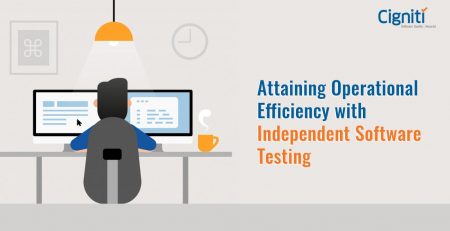Will Speed to Market and Quality Determine the Software Testing Agenda for 2017?
Speed is becoming a defining factor for every new venture in the marketplace. Whether it is a financial app, a gaming app, a VR device, or anything that is consumer-centric or enterprise facing; speed is the key to success. The next line of emphasis is on the quality and performance. Aspects such as compatibility with the Operating Systems, the devices, the enterprise ecosystem, and much more has to be taken into view.
Looking at the overall expanse, if you ask which industry will need more testing in 2017, the answer is ‘almost every’. This may sound a cliché, but the digital revolution is taking everyone by a storm and ensuring its functionality and performance is indispensable. Not a single industry or segment that involves human and machine interface can escape digital transformation.
Data and Analytics will determine the existence and success of many organizations in the long run. Case in point is Predictive Analytics, an offshoot of Advanced Analytics that is implemented to predict future events. It leverages various techniques – Data mining, Statistics, modelling, machine learning, and Artificial Intelligence for analyzing the existing data and make predictions.
Data-based predictions are bound to bring value and strengthen decision making for companies, offering competitive edge. This implies that Big Data testing is going to gain added significance – helping enterprises to predict what’s across the horizon – enabling them to deliver an experience that is enhancing and future-proof.
Manufacturing, FMCG, Telecommunications, Defence, Education, Banking & Finance, Healthcare, Pharmaceuticals, and every industry that has a consumer interface will need robust software testing mechanisms.
For instance, Robotics has already been implemented within industries such as Manufacturing, and food and confectionary goods. Its efficiency will be defined by its performance and its capability to take on load from the external factors.
Brands and enterprises that fail to incorporate changes or adopt new digital practices will lag miserably in the business race. While 2016 has been a year of experimentation, 2017 is expected to be a year for a consistent ‘test and learn’ approach. Digital trends are determining the way companies will structure and revamp their systems.
You never know, your next boss could be a robot!
Assessment of your work could be more impersonal and objective. A smart machine will do primary analysis of your work. Just estimate the kind of software testing and assurance this will require.
There is nothing like less digital or more digital. If your company is taking the digital route, you have made the choice to bring tangible efficiency and only a comprehensive software testing plan can bring about this kind of assurance. Moreover, it is not just a technological shift, it is particularly a shift in mind-set.
Digital assistants like Amazon Echo (Alexa voice system), Google Home, Apple Siri, Google Maps etc. take real time statistics and provide factual details for consumption by users. API and application testing will play a critical role in ensuring that the right context is considered as the base for making real time predictions.
Technology can exist, but it gets applied for consumers/enterprises only when it gets viable for the market and brings relevance for the users. For instance, users are expecting brands to build a stronger audio presence in 2017, which is going to be an exciting space for businesses as well. So, any new venture will bring viability only when there is sufficient demand and scope in the marketplace.
Open Source is expected to play a key role in building a more robust and market-ready digital landscape. Google’s Security engineers Daniel Bleichenbacher and Thai Duong recently launched Project Wycheproof. It is a set of security tests that detect vulnerabilities and check functionalities of a cryptographic software.
Named after the smallest mountain in the world, Project Wycheproof was built and tested on GitHub via Open Source to download and use for testing popular cryptographic algorithms such as AES-EAX and AES-GCM, and related software libraries. Interestingly, Project Wycheproof has over 80 test cases that have exposed more than 40 security bugs.
The power of Open Source is being realized by enterprises and businesses across the globe – cost of ownership and flexibility of the code – key drivers for choosing Open Source tools and software. Collaborative testing methodologies like Agile and DevOps have been adopted for its intrinsic benefits.
2017 will see a lot going this way!
The key reason is, there is no definite way of testing an application or web interface today. The landscape is uncertain and volatile. Inventive and inclusive approaches like Agile and DevOps will assure performance and market readiness. Today, testers and developers are working together in smaller teams with flexibility to make changes and consequently amplify the reach and impact of the product.
Chatbots is a hot topic, one of the key trends to watch out for in 2017. Facebook, Twitter, Whatsapp and Google are introducing bots. The purpose is to enable faster ticket booking and customer service, and are expected to even overthrow apps as the basic mode of communication over smartphones.
For instance, a bot will book a movie ticket for you, plan recreational activities for you, all on the basis of accumulated data. Reference to businesses, Chatbots are expected to aggressively support activities related to customer service – added assistance, 24*7 digital chat, accelerated response time, and easing the operational activities and sparing the humans for some complex tasks.
Even in terms of acceptance, we are fine chatting and communicating with a bot as against a human. This acceptance can only be possible with assurance that the bot will bring value and deliver the desired response for an activity. Testing its performance across applications and platforms is absolutely critical, as it is expected to impact our routine.
There are major shifts happening in digital thinking and fresh techniques for 2017. Interestingly, it is not just about technology that will drive key trends in software testing. It will be the way these products and services are created in the digital space that will determine the software testing trends.
Test Automation with regression testing will bring speed to testing and ensure that the results are recurring and consistent. Applications need that as the scenario is getting complex with increasing third party interfaces. There are numerous activities that an application facilitates, so it is essential to ensure its functionality.
Performance Testing, Functional Testing, Load and stress testing, and Security testing, will be critical in building robust consumer interfaces.
Learn – Build – Test will be the favourite strategy for businesses in 2017. Innovative businesses are not wasting time and resources on implementing new tools and features. They increasingly interact with consumers across the virtual space and then build their products/applications. Some of the successful enterprises have not gone absolutely ready to the market. The product has been built over time based on feedback.
This creates a different development landscape and testing scenario. Testing will be more reactive, responsive, and reflective of the market demands and changes. Software Development Lifecycle (SDLC) will be increasingly iterative and will need strong collaboration between in-house teams and testing partners.
Collaborating with an experienced testing partner will increasingly bring value to your business and a better ROI. A Testing Center of Excellence (TCoE) brings tremendous value to an organization in terms of enhanced quality and speed to market. Importantly, the cost of ownership is minimal.
Enterprises leverage Cigniti’s TCoE to centralize the testing function, achieve efficiency, and optimize people/tool utilization. We understand the upcoming technology challenges in 2017, and are excited to collaborate with you to further strengthen your QA and testing landscape for the digital era.





Leave a Reply